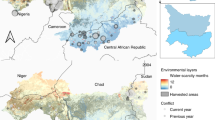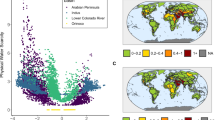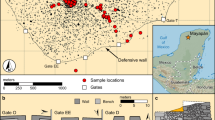Abstract
Hydroclimatic extremes have been shown to enhance conflict in fragile societies. Quantitative research in this field has historically focused on rainfall anomalies, without accounting for their effects on the water–food system. Here we explore the water–food nexus and its interlinkages with urban conflicts in Central America. We use an agrohydrological model to assess the effects of drought on water availability and food production, accounting for regional food trade. A biophysical parameterization is then coupled with an econometric Bayesian zero-inflated Poisson model to detect dynamic spatial relations among social and hydrological variables. We find that drought-induced water deficit affects food security in major cities in the region and is correlated with the rise of conflict. Moreover, low population density and higher human development enhance the probability of permanent absence of conflict. Our analysis reveals the crucial role of food redistribution between rural and urban areas and its association with livelihoods and urban violence.
This is a preview of subscription content, access via your institution
Access options
Subscribe to this journal
Receive 12 digital issues and online access to articles
$99.00 per year
only $8.25 per issue
Buy this article
- Purchase on Springer Link
- Instant access to full article PDF
Prices may be subject to local taxes which are calculated during checkout






Similar content being viewed by others
Data availability
Input data used in this analysis were retrieved from publicly available sources that are cited in the text. Results data are available in the Supplementary Information. Additional data are available from the correpsonding author upon reasonable request.
Code availability
The code used for the Bayesian econometric analysis is available from the corresponding author on reasonable request.
References
Kallis, G. & Zografos, C. Hydro-climatic change, conflict and security. Climatic Change 123, 69–82 (2014).
Zografos, C., Goulden, M. C. & Kallis, G. Sources of human insecurity in the face of hydro-climatic change. Glob. Environ. Change 29, 327–336 (2014).
Mach, K. J. et al. Climate as a risk factor for armed conflict. Nature 571, 193–197 (2019).
European Security Strategy: A Secure Europe in a Better World, Vol. 94 (Council of the European Union, 2003).
McGowan, A. H. The environment and national security. Environment 49, 10–25 (2007).
Hsiang, S. M., Burke, M. & Miguel, E. Quantifying the influence of climate on human conflict. Science 341, 1235367 (2013).
Schleussner, C. F., Donges, J. F., Donner, R. V. & Schellnhuber, H. J. Armed-conflict risks enhanced by climate-related disasters in ethnically fractionalized countries. Proc. Natl Acad. Sci. USA 113, 9216–9221 (2016).
Von Uexkull, N., Croicu, M., Fjelde, H. & Buhaug, H. Civil conflict sensitivity to growing-season drought. Proc. Natl Acad. Sci. USA 113, 12391–12396 (2016).
IPCC Climate Change 2007: Mitigation (eds Metz, B. et al.) (Cambridge Univ. Press, 2007).
Harari, M. & Ferrara, E. L. Conflict, climate, and cells: a disaggregated analysis. Rev. Econ. Stat. 100, 594–608 (2018).
Couttenier, M. & Soubeyran, R. Drought and civil war in sub‐Saharan Africa. Econ. J. 124, 201–244 (2014).
Seter, H., Theisen, O. M. & Schilling, J. All about water and land? Resource-related conflicts in East and West Africa revisited. GeoJournal 83, 169–187 (2018).
Abel, G. J., Brottrager, M., Crespo Cuaresma, J. & Muttarak, R. Climate, conflict and forced migration. Glob. Environ. Change 54, 239–249 (2019).
Bernauer, T., Böhmelt, T. & Koubi, V. Environmental changes and violent conflict. Environ. Res. Lett. 7, 15601 (2012).
Gizelis, T. I. & Wooden, A. E. Water resources, institutions, & intrastate conflict. Polit. Geogr. 29, 444–453 (2010).
Roche, K. R., Müller-Itten, M., Dralle, D. N., Bolster, D. & Müller, M. F. Climate change and the opportunity cost of conflict. Proc. Natl Acad. Sci. USA 117, 1935–1940 (2020).
Galli, N., Dell’Angelo, J., Epifani, I., Chiarelli, D. D. & Rulli, M. C. Socio-hydrological features of armed conflicts in the Lake Chad Basin. Nat. Sustain. 5, 843–852 (2022).
Selby, J. Positivist climate conflict research: a critique. Geopolitics 19, 829–856 (2014).
Ide, T., Brzoska, M., Donges, J. F. & Schleussner, C. F. Multi-method evidence for when and how climate-related disasters contribute to armed conflict risk. Glob. Environ. Change 62, 102063 (2020).
Allan, J. A. Virtual water: a strategic resource global solutions to regional deficits. Ground Water 36, 545–546 (1998).
D’Odorico, P. et al. The global food–energy–water nexus. Rev. Geophys. 56, 456–531 (2018).
Bernauer, T. et al. Climate variability, food production shocks, and violent conflict in Sub-Saharan Africa. Environ. Res. Lett. 10, 125015 (2015).
Dell’Angelo, J., D’Odorico, P., Maria & Rulli, C. The neglected costs of water peace. WIREs Water 5, e1316 (2018).
Allan, J. A. The Middle East Water Question: Hydropolitics and the Global Economy (Bloomsbury Academic, 2012).
Alcamo, J., Dronin, N., Endejan, M., Golubev, G. & Kirilenko, A. A new assessment of climate change impacts on food production shortfalls and water availability in Russia. Glob. Environ. Change 17, 429–444 (2007).
Regional Data Bank for Statistical Follow-up to the SDGs in Latin America and the Caribbean (ECLAC & UNDP, 2021).
Nett, K. & Rüttinger, L. Insurgency, Terrorism and Organised Crime in a Warming Climate (Adelphi, 2016).
Maria, A., Acero, J. L., Aguilera, A. I. & Garcia Lozano, M. Central America Urbanization Review: Making Cities Work for Central America (World Bank, 2017); https://doi.org/10.1596/978-1-4648-0985-9
Gotlieb, Y., Pérez-Briceño, P. M., Hidalgo, H. & Alfaro, E. The Central American Dry Corridor: a consensus statement and its background. Rev. Yu’am 3, 42–51 (2019).
Bonilla Vargas, A. Patrones de Sequía en Centroamérica. Su Impacto en la Producción de Maíz y Frijol y Uso del Índice Normalizado de Precipitación para los Sistemas de Alerta Temprana (Global Water Partnership, 2014); https://www.gwp.org/globalassets/global/gwp-cam_files/patrones-de-sequia_fin.pdf
Magrath, J. Coffee Rust Fungus Threatens Employment Collapse in Central America (Oxfam, 2014).
CEPALSTAT (CEPAL, 2022); https://statistics.cepal.org/portal/cepalstat
Vargas, R. et al. EDE Climate risk and food availability in Guatemala. Environ. Dev. Econ. 23, 558–579 (2018).
Cattaneo, A. et al. Economic and social development along the urban–rural continuum: new opportunities to inform policy. World Dev. 157, 105941 (2022).
Cattaneo, A., Nelson, A. & McMenomy, T. Global mapping of urban-rural catchment areas reveals unequal access to services. Proc. Natl Acad. Sci. USA 118, e2011990118 (2021).
Chiarelli, D. D. et al. The green and blue crop water requirement WATNEEDS model and its global gridded outputs. Sci. Data 7, 1–9 (2020).
CHIRPS v2.0 (Climate Hazards Group, 2015); https://doi.org/10.15780/G2RP4Q
Harris, I., Jones, P. D., Osborn, T. J. & Lister, D. H. Updated high-resolution grids of monthly climatic observations - the CRU TS3.10 dataset. Int. J. Climatol. 34, 623–642 (2014).
Allen, R. G., Pereira, L. S., Raes, D. & Smith, M. Crop Evapotranspiration: Guidelines for Computing Crop Water Requirements (FAO, 1998).
The State of Food Security and Nutrition in the World 2020 (FAO, IFAD, UNICEF, WFP & WHO, 2020); https://doi.org/10.4060/ca9692en
Doorenbos, J. & Kassam, Amir. Yield response to water. FAO Irrigation and Drainage Paper 33 (1979).
Salehyan, I. et al. Social conflict in Africa (SCAD): a new database. Int. Interact. 38, 503–511 (2012).
Arab, A. Spatial and spatio-temporal models for modeling epidemiological data with excess zeros. Int. J. Environ. Res. Public Health 12, 10536–10548 (2015).
FAO. Human energy requirements: report of a joint FAO/WHO/UNU Expert Consultation. Food Nutr. Bull. 26, 166 (2005).
Bazzi, S. & Blattman, C. Economic shocks and conflict: evidence from commodity prices. Am. Econ. J. Macroecon. 6, 1–38 (2014).
Central America – Livelihood Zones (FEWS NET, 2016).
Gleick, P. H. Water, drought, climate change, and conflict in Syria. Weather Clim. Soc. 6, 331–340 (2014).
Müller, M. F., Yoon, J., Gorelick, S. M., Avisse, N. & Tilmant, A. Impact of the Syrian refugee crisis on land use and transboundary freshwater resources. Proc. Natl Acad. Sci. USA 113, 14932–14937 (2016).
Taylor, M. J., Aguilar-Støen, M., Castellanos, E., Moran-Taylor, M. J. & Gerkin, K. International migration, land use change and the environment in Ixcán, Guatemala. Land Use Policy 54, 290–301 (2016).
Aguilar-Støen, M. Between a rock and a hard place: rural transformations and migrant communities in Guatemala. Can. J. Dev. Stud. 41, 57–73 (2020).
Conceicao, P. & Kim, N. The economic crisis, violent conflict, and human development. Int. J. Peace Stud. 15, 29–43 (2010).
Hoeffler, A. in Conflict, Political Accountability and Aid 1–34 (Routledge, 2013).
Satyanath, S., Sergenti, E. & Miguel, E. Economic shocks and civil conflict: an instrumental variables approach. J. Political Econ. 112, 725–753 (2012).
Müller, M. F. & Levy, M. C. Complementary vantage points: integrating hydrology and economics for sociohydrologic knowledge generation. Water Resour. Res. 55, 2549–2571 (2019).
Miguel, E. & Satyanath, S. Re-examining economic shocks and civil conflict. Am. Econ. J. Appl. Econ. 3, 228–232 (2011).
Brück, T. et al. The Relationship Between Food Security and National Security (International Security and Development Centre, 2016).
Martin-Shields, C. P. & Stojetz, W. Food security and conflict: empirical challenges and future opportunities for research and policy making on food security and conflict. World Dev. 119, 150–164 (2019).
Elhorst, J. P. Spatial Econometrics From Cross-Sectional Data to Spatial Panels Vol. 16 (Springer, 2014).
Gelman, A., Meng, X. L. & Stern, H. Posterior predictive assessment of model fitness via realized discrepancies. Stat. Sin. 6, 733–807 (1996).
Famine Early Warning Systems Network – Markets and Trade (FEWS NET, 2012).
Hoekstra, A. Y. & Mekonnen, M. M. The water footprint of humanity. Proc. Natl Acad. Sci. USA 109, 3232–3237 (2012).
Doorenbos, J., Kassam, A. H., Bentvelsen, C. & Uittenbogaard, G. in Irrigation and Agricultural Development (ed. Johl, S.) 257–280 (Elsevier, 1980).
Marsal, J. Crop Yield Response to Water (FAO, 2012).
Guha-Sapir, D., Below, R., Hoyois, P. EM-DAT (CRED, 2019).
Hijmans, R., Kapoor, J., Garcia, N., Wieczorek, J. & Mandel, A. GADM v.2.8 (GADM Maps and Data, 2015); http://gadm.org
Human Geography Map (ESRI, 2021); https://www.arcgis.com/home/item.html?id=3582b744bba84668b52a16b0b6942544
Acknowledgements
M.C.R. acknowledges support from the European Union’s Horizon 2020 research and innovation programme under the Marie Skłodowska-Curie Action (MSCA) Innovative Training Network (ITN) grant agreement no. 861509–NEWAVE. M.C.R. and N.G. are supported by ENI Enrico Mattei Foundation (FEEM), Cariplo Foundation (SusFeed project no. 0737 CUP D49H170000300007) and Regione Lombardia (RUD0CONV01/ASSO project D44I20002000002).
Author information
Authors and Affiliations
Contributions
M.C.R., I.E., P.D. and M.S. conceived and designed the research. M.S. and N.G. collected and analysed data. M.S. wrote the paper with input from all co-authors.
Corresponding author
Ethics declarations
Compliance with ethical standards Competing interests
The authors declare no competing interests.
Peer review
Peer review information
Nature Water thanks Marc Muller, Molly Brown and Hadi Jaafar for their contribution to the peer review of this work.
Additional information
Publisher’s note Springer Nature remains neutral with regard to jurisdictional claims in published maps and institutional affiliations.
Supplementary information
Supplementary Information
Supplementary Methods, Notes, Figs. 1–32 and Tables 1–8.
Supplementary Data 1
Full dataset of the variables used in the Bayesian econometric model.
Rights and permissions
Springer Nature or its licensor (e.g. a society or other partner) holds exclusive rights to this article under a publishing agreement with the author(s) or other rightsholder(s); author self-archiving of the accepted manuscript version of this article is solely governed by the terms of such publishing agreement and applicable law.
About this article
Cite this article
Sardo, M., Epifani, I., D’Odorico, P. et al. Exploring the water–food nexus reveals the interlinkages with urban human conflicts in Central America. Nat Water 1, 348–358 (2023). https://doi.org/10.1038/s44221-023-00053-0
Received:
Accepted:
Published:
Issue Date:
DOI: https://doi.org/10.1038/s44221-023-00053-0



